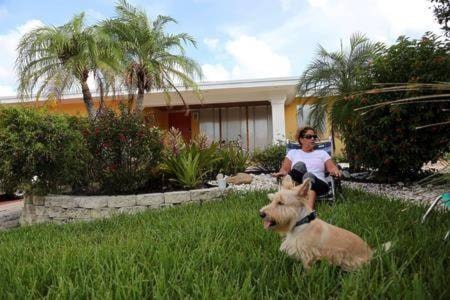REDDINGTON SHORES, Fla. — Carl Roberts has a stash of Chinese food, a case of water and a million-dollar view in his 17th floor Gulf front condo.
And that, he says, is all he needs to hunker down through a massive storm coming straight at him.
Authorities have beseeched more than 6 million people in Florida and Georgia to evacuate before Hurricane Irma’s storm surge and fierce winds make leaving — or rescuing — impossible. But some around Florida are choosing to stay, a rite of passage for many in the state who boast about the storms they weathered: Camille, Andrew, Katrina and others.
“No. 1, I don’t have anywhere to go,” said Roberts, an attorney. “Hurricane damage is primarily water rising. And I’m on the 17th floor. I have security shutters, so I should be quite safe here.”
All residents of Pinellas County’s barrier islands, like where Roberts lives in Reddington Shores, are under a mandatory evacuation order. But Roberts thinks he’ll only lose power for a day or two.
And he’s clearly not alone in not heeding the call.
In the elevator, another resident of the condo tower was toting a 12-pack. He told Roberts that he wasn’t leaving, either.
“Where ya gonna go?” the man asked, then got out on the 15th floor.
Hunkering down isn’t just happening on Florida’s west coast.
As Hurricane Irma threatened catastrophic damage to Florida, patrons at the most infamous South Beach dive bar tossed back drinks, shot pool and played the jukebox loud.
Clouds of cigarette smoke floated in the air at Mac’s Club Deuce where Miami Beach resident Kathleen Paca, 56, was perched on a stool. She’d just finished spray painting “We’re Open Irma” on the bar’s plywood window protections. The word “Irma” covered “Wilma,” the 2005 hurricane when the plywood last was used.
Paca and other regulars at the Deuce, as it’s known to locals, had no qualms about staying home as Irma approached, even with the storm projected to be one of the strongest to ever make landfall in Florida.
“Where am I going to go?” Paca said. “It’s not going to be that bad. I’m on the second floor and have impact windows. I’ve thrown coconuts at my windows and they don’t break.”
Despite officials calling for more than 6 million people in Florida and Georgia to evacuate in advance of Irma’s storm surge and fierce winds, some around Florida are choosing to stay, a rite of passage for many in the state who boast about the storms they weathered: Camille, Andrew, Katrina and others.
While many of the state’s poor have little choice but to stay put at home or head to a shelter, some people who can choose are opting to ride the storm out rather than risk driving hundreds of miles north with no sure source of gasoline or accommodations.
“I have two choices, stay or run north, a bad idea” said Michel Polette, 31, who lives a couple of blocks from the Atlantic Ocean in South Beach. “If you drive to Atlanta or Tallahassee, you’re risking running out of gas and being in your car in a Category 4 hurricane.”
Residents at the Treasure Village Mobile Home Park in St. Petersburg, about four hours northwest of Miami Beach, said they weren’t leaving either — even though the county called for an evacuation of all mobile homes, regardless of whether they were inland or near the water.
“I’m not going anywhere,” said 56-year-old Laurie Mastropaolo, who wore a T-shirt with a photo of the iconic “Grumpy Cat” that said, ‘This is my happy face.’
Mastropaolo was talking to a neighbour, 79-year-old William Castor. Castor, shirtless in the 95-degree heat, said he hadn’t yet heard about the mandatory mobile home evacuation. County and city officials hadn’t yet come to the park.
“The storm’s 1,000 miles away,” he shrugged. “It could go to Kalamazoo.”
Castor was raised in Miami, and Mastropaolo said she weathered storms on Long Island, including Sandy. Neither has lived in the park for a year, and neither was convinced that it was necessary to leave for Irma, at least not yet.
“If I lived in Miami, I’d be outta there,” said Mastropaolo. “But here, I’ll wait till the last minute. I’m not going to get on the road with the crazy people.”
Said Castor: “I’m not saying you should ignore it, but it’s gotta get closer for me to decide.”
Making the decision to stay is often made by people who feel they have a strong social support system who will help them through the hardship, a study published by the American Meteorological Society earlier this year found. The study was based on data gathered during 2016’s Hurricane Matthew, which flooded northeast Florida, destroying homes in St. Augustine and the surrounding area with floodwaters.
“We got the opposite results from what I expected because those who stayed and who were under mandatory evacuation, they had more dependable social networks than those who evacuated,” said Jennifer Collins, one of the University of South Florida researchers who conducted the study. “Their neighbourhoods and local communities — they felt very comfortable to hunker down with them.”
Some people in Miami felt mixed about their decision to stay put, but were influenced to do so by special circumstances, like pregnancy.
Stefani Travieso, 22, lives in a Miami neighbourhood that was badly damaged during Hurricane Andrew in 1992. She is eight months pregnant and her doctor told her to stay in a comfortable place where she felt safe. Since Andrew her roof has been replaced, and storm windows installed along with a backup generator.
“If I wasn’t pregnant, I’d be in the car headed north with my dog and my husband,” she said.
